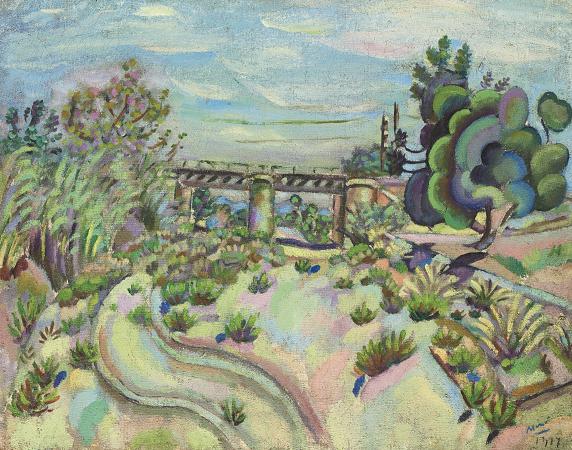Joan Miro (1893 - 1983). Joan Miró i Ferrŕ was a Spanish painter, sculptor, and ceramicist born in Barcelona. A museum dedicated to his work, the Fundació Joan Miró, was established in his native city of Barcelona in 1975, and another, the Fundació Pilar i Joan Miró, was established in his adoptive city of Palma de Mallorca in 1981. Earning international acclaim, his work has been interpreted as Surrealism, a sandbox for the subconscious mind, a re-creation of the childlike, and a manifestation of Catalan pride. In numerous interviews dating from the 1930s onwards, Miró expressed contempt for conventional painting methods as a way of supporting bourgeois society, and declared an assassination of painting in favour of upsetting the visual elements of established painting. Born into a family of a goldsmith and a watchmaker, Miró grew up in the Barri Gňtic neighborhood of Barcelona. The Miró surname indicates Jewish roots. His father was Miquel Miró Adzerias and his mother was Dolors Ferrŕ. He began drawing classes at the age of seven at a private school at Carrer del Regomir 13, a medieval mansion. To the dismay of his father, he enrolled at the fine art academy at La Llotja in 1907. He studied at the Cercle Artístic de Sant Lluc and he had his first solo show in 1918 at the Galeries Dalmau, where his work was ridiculed and defaced. Inspired by Fauve and Cubist exhibitions in Barcelona and abroad, Miró was drawn towards the arts community that was gathering in Montparnasse and in 1920 moved to Paris, but continued to spend his summers in Catalonia. Miró initially went to business school as well as art school. He began his working career as a clerk when he was a teenager, although he abandoned the business world completely for art after suffering a nervous breakdown. His early art, like that of the similarly influenced Fauves and Cubists, was inspired by Vincent van Gogh and Paul Cézanne. The resemblance of Miró's work to that of the intermediate generation of the avant-garde has led scholars to dub this period his Catalan Fauvist period. A few years after Miró's 1918 Barcelona solo exhibition, he settled in Paris where he finished a number of paintings that he had begun on his parents' summer home and farm in Mont-roig del Camp. One such painting, The Farm, showed a transition to a more individual style of painting and certain nationalistic qualities. Ernest Hemingway, who later purchased the piece, compared the artistic accomplishment to James Joyce's Ulysses and described it by saying, It has in it all that you feel about Spain when you are there and all that you feel when you are away and cannot go there. No one else has been able to paint these two very opposing things. Miró annually returned to Mont-roig and developed a symbolism and nationalism that would stick with him throughout his career. Two of Miró's first works classified as Surrealist, Catalan Landscape and The Tilled Field, employ the symbolic language that was to dominate the art of the next decade. Josep Dalmau arranged Miró's first Parisian solo exhibition, at Galerie la Licorne in 1921. In 1924, Miró joined the Surrealist group. The already symbolic and poetic nature of Miró's work, as well as the dualities and contradictions inherent to it, fit well within the context of dream-like automatism espoused by the group. Much of Miró's work lost the cluttered chaotic lack of focus that had defined his work thus far, and he experimented with collage and the process of painting within his work so as to reject the framing that traditional painting provided. This antagonistic attitude towards painting manifested itself when Miró referred to his work in 1924 ambiguously as x in a letter to poet friend Michel Leiris. The paintings that came out of this period were eventually dubbed Miró's dream paintings. Miró did not completely abandon subject matter, though. Despite the Surrealist automatic techniques that he employed extensively in the 1920s, sketches show that his work was often the result of a methodical process. Miró's work rarely dipped into non-objectivity, maintaining a symbolic, schematic language. This was perhaps most prominent in the repeated Head of a Catalan Peasant series of 1924 to 1925. In 1926, he collaborated with Max Ernst on designs for ballet impresario Sergei Diaghilev. With Miró's help, Ernst pioneered the technique of grattage, in which one trowels pigment onto a canvas then scrapes it away. Miró returned to a more representational form of painting with The Dutch Interiors of 1928. Crafted after works by Hendrik Martenszoon Sorgh and Jan Steen seen as postcard reproductions, the paintings reveal the influence of a trip to Holland taken by the artist.
more...








